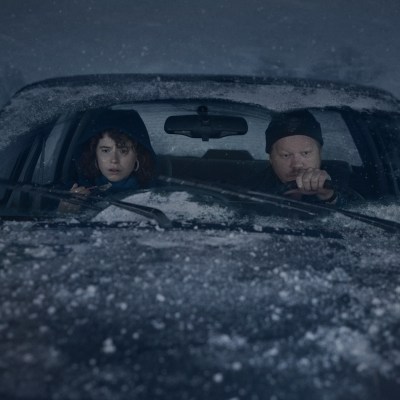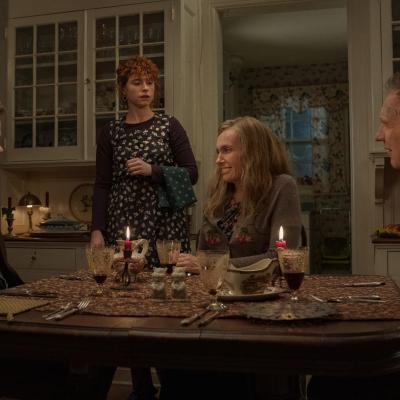How I’m Thinking of Ending Things Book and Film Differences Make For Perfect Complements
Iain Reid’s novel I’m Thinking Of Ending Things and Charlie Kaufman’s movie adaptation have significant differences and the two work together gloriously.
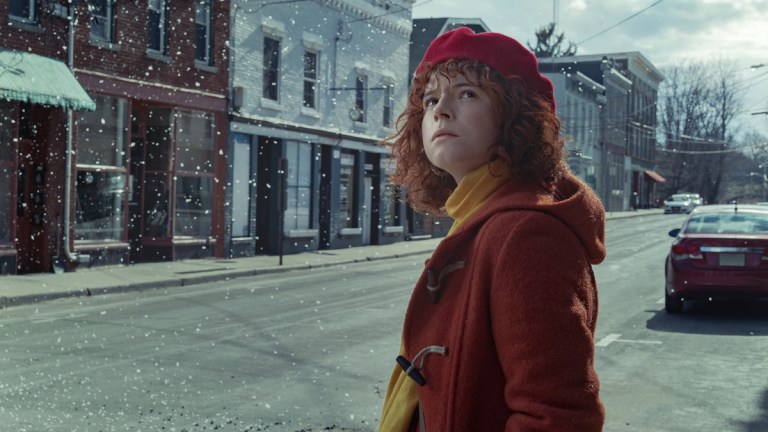
Charlie’s Kaufman’s filmic interpretation of Iain Reid’s celebrated novel I’m Thinking Of Ending Things has arrived on Netflix and it’s a complicated, beautiful, confusing work – certainly unless you watch it twice. The book and the film sit wonderfully together, both broadly the same narrative but both leaning into different strands and elements, with the movie picking up half-hinted at threads from the book. They both work, but in different ways.
If you were wondering whether you should read the book first or watch the film, the answer is read the book. Not because it’s necessarily better – the two are different beasts – but because reading the book could enhance your enjoyment of the film, while watching the film first may well dilute your enjoyment of the book. And there’s a reason for that…
Here’s our breakdown of where the two diverge.
Spoilers for I’m Thinking Of Ending Things – both book and film – to follow.
The Genre
If you can, you must read the book first because the book is a horror/thriller. If you already know the ending of the book it just isn’t anywhere near as scary – and approached cold for the first time, this is a really unsettling read.
The film has horror elements but it has more in common with Kaufman’s Synecdoche, New York – a beautiful, existential lament – a tragedy with elements of horror, thriller and mystery that encourages the viewer to understand what they are watching much earlier. It’s not so much of a ‘twist’ as a slow reveal.
Having already read the book might remove some of the mystery elements but the film is so evocative and sad and there’s still loads to be gained even if you know the deal from the off.
The Plot
Broadly speaking it’s the same. An unnamed female narrator is on a trip with her boyfriend Jake to visit his parents but she is having doubts about the relationship. The voiceover from the start of the film is exactly how the book begins, and the book talks a lot about thought. How once a thought is there, it sticks, and how only thought is really ‘truth’ – that you can fake actions but not thoughts.
The two drive to the farmhouse whilst discussing various philosophical and existential ideas along the way. She relates their meet-cute – they’re at a pub quiz, his team name is Brezhnev’s Eyebrows, he uses the words ‘ipseity’ and ‘cruciverbalist’ – which she doesn’t understand.
They have an uncomfortable and awkward dinner with the parents, and the narrator finds a picture that looks like her, some disturbing paintings in the basement (more on this later) and has awkward individual conversations with both parents.
They leave, go to an ice cream shop (but in the book they get frozen lemonade – much is made of the narrator’s lactose intolerances), then head to the school where he disposes of the cups, returns to the car, the two start making out but Jake says he sees a man watching him. He gets out to give the guy a piece of his mind and then disappears into the school.
The narrator eventually follows, spies the janitor, and tries to find Jake in the school. The finer details of the plot diverge at this point (again, more later) but it is revealed that Jake, the narrator and the janitor are all the same person and Jake kills himself.
The Phone Calls
In the book and the film the narrator receives incessant phone calls which she doesn’t want to pick up. In the book we are told these calls are coming from her own number. It’s harder, of course, to get that fact across in the movie, when the narrator is nameless so instead in the movie they come from names like Louisa and Yvonne – Louisa is a name that Jake’s parents have called her, and Yvonne is the name of the character in the romcom that the janitor watches and later borrows the storyline from.
This means on a rewatch you understand the calls are coming from herself – or rather the janitor – but they don’t have the same level of creepiness as in the book. In the film, at the start where we see the person who turns out to be the janitor muttering in his apartment, what he is saying is what she hears on the answer phone.
The message is this:
“There is only one question to resolve. I’m scared. I feel a little crazy. I’m not lucid. The assumptions are right. I can feel my fear growing. Now is the time for the answer. Just one question. One question to answer.”
In the book these calls are constant, have been going on for a while, and are really menacing. The voice is described as man’s, middle aged or older, with a feminine element to it. She says she hasn’t told Jake about the calls which often come in the middle of the night, around 3.00am and at times she will wake to find she has had 12 missed calls.
Things get creepier still. Eventually there’s an extra element of the message. The voice adds:
“Now I’m going to say something that will upset you: I know what you look like. I know your feet and hands and your skin. I know your head and your hair and your heart. You shouldn’t bite your nails.”
The narrator freaks the hell out and resolves to answer the next time the man calls to confront him. So she does. She screams:
“Why are you calling me? How did you get my number? You can’t keep doing this,” and then “This is about you. I can’t help you!”.
And the voice replies:
“But you called me.”
Brrrrrr
The calls are of course Jake’s suicidal thoughts plaguing him.

The Title
Though at first glance the title means the same thing in both the book and the film, there’s a detail in the book that’s less obvious in the film.
We begin with that phrase – in the narrator’s voice – and we understand it refers to her ending the relationship with Jake. By the end of the film, and the book, we realise that in fact it’s the narrator/Jake/the janitor thinking of ending their life.
But the ominous phone calls which are very present in the book (more than the film) hammer home this idea of ‘the question’ – “One question to answer.” as the message concludes.
What is that question then? The book teases several possibles – there’s the remembered scene with Mrs Veal, a woman who would come to the house to collect bacon fat (it’s all so very unsettling), asking the young narrator (but Jake of course) “are you good or bad?” Could this be the one question?
And of course the central question could also be ‘should I kill myself?’. But the book gives us one last gut punch answer, which is also referenced in the movie. There’s a poster in the school corridor which reads “Dancing The Night Away. Tickets at $10. What are you waiting for?”
Then in the book there are four pages of just that phrase ‘What are you waiting for?’
The exchange then becomes:
I’m thinking of ending things.
What are you waiting for?
The Structure
While the main narrative of the two is the same, the book has an added structural element. Though the main body of the text is written in first person, told by the narrator, between each chapter is inserted a snippet of a conversation. This is presented in italics and these voices are very clearly not the narrator. The conversations gradually tell the story of a man who has killed himself in the school, he’s found in a closet and had locked up the school from the inside.
We learn he was a very lonely, isolated man who was highly intelligent and worked as a school custodian (janitor), who had become almost non verbal, who had no wife and kids and whose parents were long dead. He had been working at a school for 30 years after a failed academic career of some sort. He had been exhibiting strange behaviour and developed a rash on his arms and neck. We come to understand that the chat is probably between people who work at the school – the person who hired him is one of them.
We learn that he had bad hearing, lactose intolerance, and was very uncomfortable around people, taking his breaks sitting outside the school in his truck. The voices speculate that despite his high level of intelligence he probably took this job because he wouldn’t have to interact with anyone. They muse that for someone who wants to be alone, taking a job in a school where you are surrounded by people is probably a kind of self-torture. Finally we understand that a journal or a long piece of writing belonging to Jake has been found with the body, it’s a story of sorts. And of course, at the very end we understand that this story (minus the conversation sections) is the book we have just been reading – encouraging us to go back and read again with new eyes.
The film doesn’t include this element, however it takes pains to give us this detail about the janitor in other ways which actually inform major chunks of the movie. While in the book there’s only the subtlest nods to the parents’ mortality during the dinner – with the fact that they died years ago confirmed by the intercut conversation – in the film it all plays out there and then. We see his folks throughout the ages, his mum when Jake was just a boy, to her becoming fragile and barely able to feed herself and finally laid out as if dead, while his father often talks of her in the past tense.
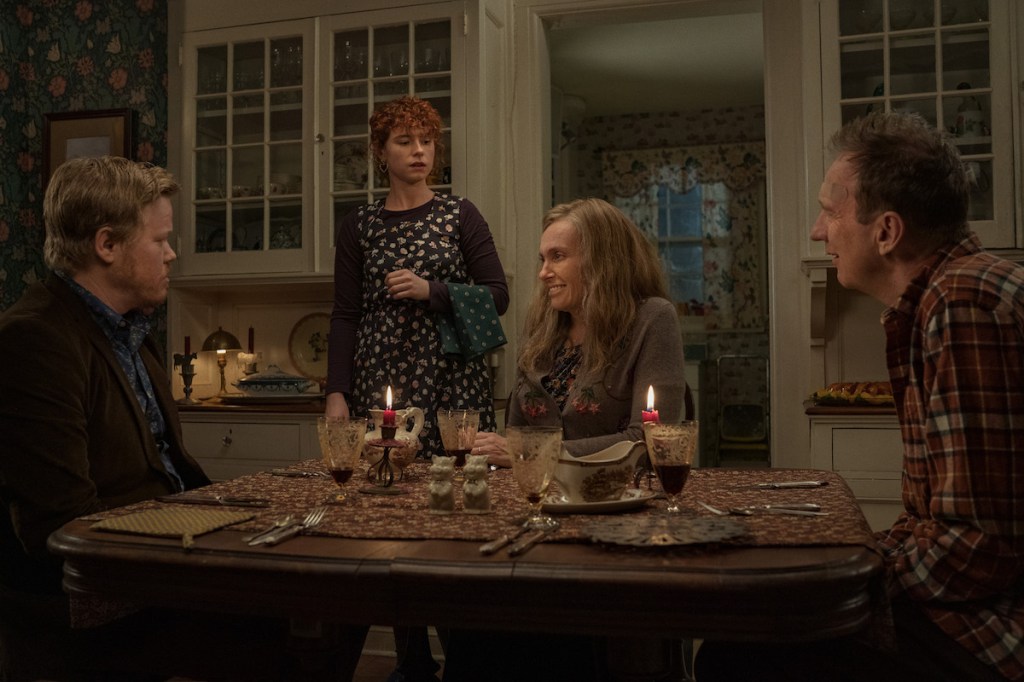
Jake and the Narrator
The book is told from the narrator’s point of view and our picture of who Jake is as a character is told through her eyes. Until of course you realise that the reader’s sense of who the narrator is, is in fact coming through the grown up Jake’s eyes. In short: we think the narrator is telling us about Jake, but actually Jake is telling us about the narrator (telling us about Jake…)
The film, though, takes a slightly different approach and it’s a credit to Jessie Buckley in particular that she is able to make the narrator feel like a real person with whom we can empathise despite actually being a cypher. The book leans hard into the horror elements so our relationship with the narrator in the book and the film is different. In the book we are afraid for her, more and more as things get weirder and weirder until she finds herself in the school, discovers the doors have been locked behind her and hides for several hours, pursued, she thinks by the janitor. It’s only at the very end that we understand they are all one and the same.
In the film she’s a more mutable character. She changes from exuberant, passionate, and sharp, to argumentative and then of course there’s the poem she recites for Jake and her Pauline Kael transformation, none of which happen in the book.
Rather than visceral horror then, Kaufman’s movie seems to want to get further into who Jake is so rather than blindly stumbling terrified towards the finale, we gradually grow to see what’s going on. The pop culture references – Kael, David Foster Wallace, Oklahoma!, the poem, the speech from A Beautiful Mind at the end – are all Kaufman and not from the book. He’s exploring from where a man like Jake would take his reference points for his final fantasy.
In the book our sense of Jake is slightly different. Jake is tall and slim and we get the sense he’s rather handsome in a slightly odd way. At the start we find him quite charming and we’re not sure why the narrator would want to end things with him, it seems like they’re good together, though as the book progresses that falls away. In the book Jake has a job in a lab, and it’s he who has to work in the morning, though his parents hint to the narrator that he’d actually lost that job.
In the movie though, Jake, as played by Jesse Plemons, is awkward and a little unsettling almost from the off. Though the Plemons version of Jake is still a construct of the janitor this Jake is less the funny, charming conversationalist we meet in the book and more hewn to what the real Jake was like at that age – frustrated and plagued with self loathing.
In the dance sequence in the school we do get a glimpse of idealised Jake in a happy relationship with the idealized narrator until the evil janitor comes along and ruins it by killing off the good version of Jake.
Changing Clothes
“When Jake’s mom returns to the table she is wearing a different dress. No one else seems to notice. Maybe she does this all the time? Changing outfits for dessert? It’s a subtle change. The same style of dress but a different color. Like a computer glitch caused a small distortion to the dress.”
Kaufman has taken this paragraph and run with it. In the book this is just another odd unsettling detail which occurs during the meal. In Kaufman’s film though the clothes are the first key indicator of what’s going on, the audience’s best shot of going on the journey with Kaufman. It’s great for creating atmosphere too.
The Paintings
In both the book and film the narrator sneaks into the basement alone, where Jake is afraid to go and finds a series of paintings. In the film these are emulations of prints stuck to the walls of the basement painted by someone else. These are the same paintings that earlier the narrator has shown (on her phone) to Jake’s parents presented as her work – it’s thematically similar to the poem she recites claiming it as her own – the poem is called “Bonedog” and it’s by Eva H.D from the book Rotten Perfect Mouth which we see in Jake’s room – her morphing into Pauline Kael (there’s a book of Kael’s work in his room too) and Jake’s final speech, from A Beautiful Mind.
In the book however, the paintings are much stranger. These depict the basement itself and in each one there is a tall figure with long fingernails and a blank face, and a child. The figure sometimes has horns, sometimes breasts, sometimes a penis, sometimes both. The basement, we are told, can only be locked from the inside.
This is very much open to interpretation but the basement locked from the inside full of terrifying imagery seems metaphorical for Jake’s mind and the dark thoughts he lives with. Later we learn he has locked up the school from the inside when he takes his own life.
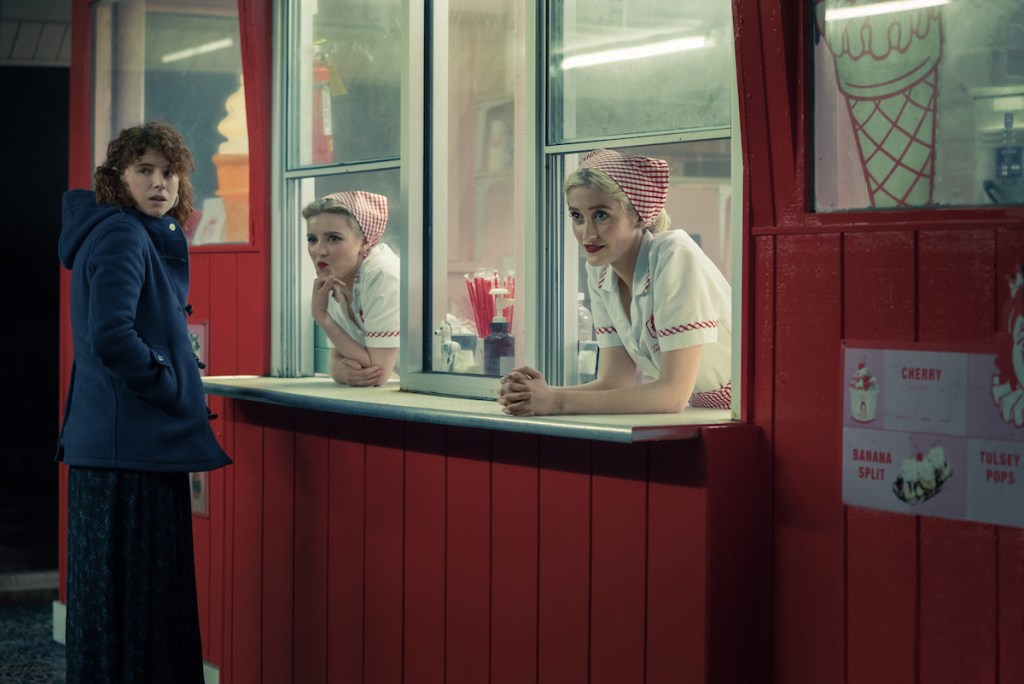
The Ice Cream Shop
The scene at the ice cream shop is similar in both book and film though there are small differences. In the book it’s a Dairy Queen but they couldn’t get the rights to use this in the film so it becomes a ‘Tulsey Town’. In the book the narrator – and so, Jake – is lactose intolerant so they order frozen lemonade rather than ice cream.
In both, the girl with the rash on her arms says she is frightened for the narrator – given that all the characters are in Jake’s mind, she is just another facet of him. In the film the girl talks about a certain hardness that comes with being pretty and compliments the narrator saying she doesn’t have this. It’s Jake, musing on his experiences with women, imagining that the girl he met in the bar that time, embodied as the narrator, wouldn’t be like those girls.
The dumpster of ice cream cups in the film doesn’t appear in the book. It’s a great scary moment but it’s also an indicator that he has taken this journey many times before and has played this endgame in his mind over and over.
The book reveals at the end that what we have been reading – minus the conversations between chapters – is the story Jake has written, his long-form suicide note, and that we should read it again with fresh eyes.
The film translates this idea from book to film format. It’s almost as if the book is what a writer’s suicide note would look like – a literary novel that becomes a publishing sensation – and the film is what a filmmaker’s suicide note would look like, packed with a selection of his favorite art, poetry, film, musical, and literary references.
The Ending
In the film, after the dance sequence which ends with the dance version of the janitor murdering the dance version of Jake, we see Jake and the narrator standing over the dance Jake’s corpse, and the two part ways. The janitor cleans the mess left by the dance, puts away his mop and buckets in his office and heads out to his truck. Here he finally breaks down. Instead of driving home he sits shivering and crying in the freezing cold. Eventually he removes his clothes, and has a vision of the Tulsey Town ice cream clown jingle.
Then the animated pig comes to take him to deliver his final speech from A Beautiful Mind, plus to sing Oklahoma!’s A Lonely Room. We finally fade down to an icy blue which fades up on the janitor’s truck completely submerged in snow, presumably with the janitor inside dead from hypothermia.
It’s actually a rather gentler ending than the one in the book.
In the book the terrified narrator comes into the school and finds the doors have been chained behind her, she runs through halls and corridors searching for Jake, finds herself in the art room where there’s red paint everywhere eventually retreating to the janitor’s room where we gradually understand that Jake, narrator and janitor are all one. The ‘janitor’ hands the ‘narrator’ a wire coat hanger which ‘she’ straightens and plunges into ‘her’ neck repeatedly and bleeds out from within a cupboard leaving the pages of the story that we have just read beside the body.
While the film is sad, beautiful, wistful the book is pretty devastating and decidedly bleak. Both work. Both sit side by side as perfect companion pieces, each complementing the other as one more meta narrative, allowing the reader/viewer to choose which version of Jake’s end of life fantasy they want to go with.

